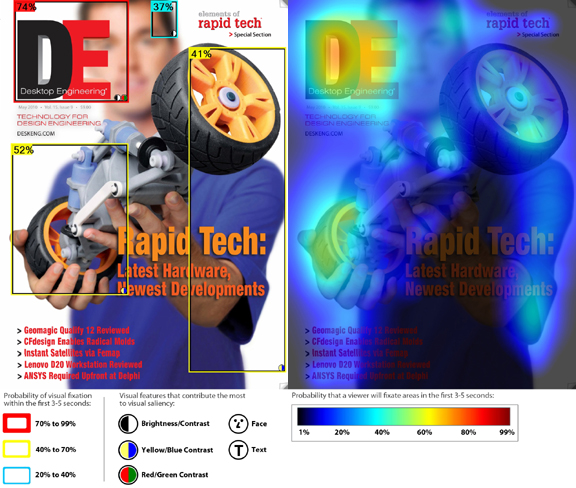Latest News
May 24, 2010

Long ago, as junior editor partly responsible for magazine layouts, I learned to balance graphics, text, and content on pages. I had to make sure the headlines were big, bold, and bright, but not so much that they’d drown out the rest. I had to prioritize the the illustrations, screen shots, and charts so they didn’t compete for attention and clutter the page. When I was in doubt, I turned to the more seasoned production editor for a second opinion.
A few weeks ago, 3M, the company whose post-it notes are as ubiquitous as the air we breathe, launched a web-hosted application called Visual Attention Service. This is where junior production editors could have turned to if a seasoned editor weren’t around to offer layout advice.
The way it works is quite straightforward. You upload your graphics (say, a mockup magazine cover, brochure, or home page) as a JPEG to 3M’s portal. Then you tag different regions of the graphics as texts or images. Afterward, you let the hosted app run its algorithms on your file. In just a few seconds, you’ll be able to view an annotated report and a heat map explaining which regions will get the most attention, which regions less, and which the least. You pay for 3M’s service with credits, which you can buy in bundles. The greater your purchase in volume, the lower the cost is for each credit. ($20 per credit if you buy 1-9, $17 each for 10-49, $14 each for 50-99, and so on.)
3M’s new service is a textbook example of Software as a Service (SaaS), a model that can—and should—be applied to finite element analysis (FEA), rendering, simulation, 3D format conversion, and other computing-intensive operations CAD users often perform. Granted, certain nagging issues may be harder to solve in SaaS CAD than they are in 3M’s platform.
The risk associated with accidentally exposing an early version of a magazine cover or a poster to the public is fairly minimal; leaking details from a confidential engineering project could result in legal, financial liabilities. Therefore, SaaS CAD would have to give greater security assurances. In addition, an average computer user’s bandwidth is quite sufficient to handle high-resolution JPEGs, but the same cannot be said of large 3D CAD assemblies. So presenting 3D FEA and simulation results as animations—and steaming them over the web in manageable packets—would require both processing power and sophisticated compression technologies. Similar SaaS applications for CAD users include Dezineforce (FEA on demand), Reality Server (cloud rendering), Autodesk Project Twitch (browser-based CAD), and Autodesk Project Butterfly (browser-based viewing and collaboration).
3M implemented its Visual Attention Service platform using Microsoft Azure. I’m working with PR folks to identify and interview the people behind 3M’s new service to better understand the science and technology behind it. Stay tuned.
Subscribe to our FREE magazine, FREE email newsletters or both!
Latest News
About the Author
Kenneth Wong is Digital Engineering’s resident blogger and senior editor. Email him at [email protected] or share your thoughts on this article at digitaleng.news/facebook.
Follow DE





